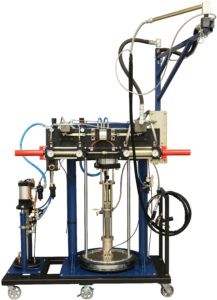2 Part Adhesive Dispensing Equipment
2 part (or two-component) adhesives are preferred for their storage stability that comes from separating their reactive components – resin and hardener. These two components should be mixed in the prescribed proportion to obtain the desired adhesive properties. Adhesive manufacturers use a two-component adhesive dispensing system (MMD machines) to ensure the ratio is accurate and to dispense the adhesive as per their requirements.

Four Common Adhesives Used In 2 Part Adhesive Dispensing Systems:
Silicones
Silicones are a preferred two-component adhesive for production applications in the automotive and window manufacturing industries, as well as the home appliance industry. These adhesives are commonly used in producing electronic parts and electrical devices where the adhesive film thickness requirement is more than 6mm. They are preferred over single-component silicone adhesives as the available air humidity is not enough to ensure complete curing in most cases.
Urethanes
Urethane adhesives are preferred for their suitability for varying cured property requirements. They can be used for various materials such as glass and metals and serve different cured properties, ranging from hard and rigid, to tough and elastic, to soft and flexible. Their versatile nature places them among the most preferred two-component adhesives.
Epoxies
Epoxies are used in a two-component adhesive dispensing system where fast-curing properties are required. Being one of the most popular two-component adhesives, they usually offer 2 to 5 minutes of work-life. These adhesives produce rigid, brittle bond lines and are used for different materials such as plastic, metal, glass, and fiber-reinforced plastic, to name a few.
Methyl Methacrylate
In case your products require a faster strength build-up than that provided by epoxy two-component adhesives, you can opt for Methyl methacrylate adhesives (MMA) and get the desired strength build-up. These adhesives can be used to bond plastics together or to bond plastic and metal in some cases. They are primarily used in rail car manufacturing and automobile manufacturing industries.
The Bottom Line
Two-component adhesives provide manufacturers with the desired strength build-up and cured properties. While they can be hand-mixed for small applications, they may be prone to several issues, including inaccuracy and waste losses. That is the reason it is always wise to use a two-component adhesive dispensing system for thorough mixing and proper metering of the desired ratio.
Two-Part Adhesive Dispensing Equipment
There are many ways to categorize different two-part adhesive dispensing equipment, but here are 2 categories in particular that will help you narrow down your next (or first) equipment purchase:
- Volume: In what size containers will your base (resin) and catalyst (hardener) be packaged? 1-gallon, 5-gallon, or 55-gallon adhesive kits are the common sizes in the U.S.. Often the adhesive kits will be sold in different sizes between the base and catalyst, if there is a large discrepancy in their ratio (for example: 10 base for every 1 catalyst). There are all kinds of configurations in adhesive dispensing equipment that will accommodate the two-part adhesive in question. Examples: 5-gallon Base and 5-gallon Catalyst, 55-gallon Base and 5-gallong Catalyst.
- Application: Where and how will your adhesive be applied in the end? Will the adhesive be applied directly from the adhesive dispensing system onto the end surface via hoses and a hand-held applicator? Or will the system be designed for filling pre-mixed cartridges for freezing and later application (or PMF cartridges)? Or will the system be used as a metering and supply system to a robotic plotting table? Or maybe some other end goal?
Other factors can affect types of 2-part adhesive dispensing equipment, like viscosity, fillers in the adhesive, or heating, but over all the main categories are 1. Volume (how much) and 2. Application (where will it go and how).
